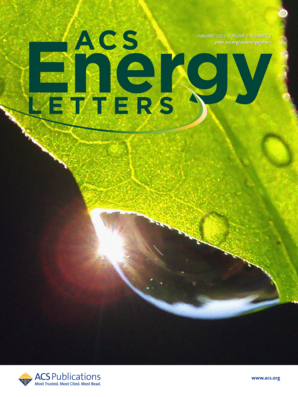Imidazolium-Based Ionic Liquid Electrolytes for Fluoride Ion Batteries
IF 19.3
1区 材料科学
Q1 CHEMISTRY, PHYSICAL
引用次数: 0
Abstract
The fluoride-ion battery (FIB) is a post-lithium anionic battery that utilizes the fluoride-ion shuttle, achieving high theoretical energy densities of up to 1393 Wh L–1 without relying on critical minerals. However, developing liquid electrolytes for FIBs has proven arduous due to the low solubility of fluoride salts and the chemical reactivity of the fluoride ion. By introducing a chemically stable electrolyte based on 1,3-dimethylimidazolium [MMIm] bis(trifluoromethanesulfonyl)imide [TFSI] and tetramethylammonium fluoride (TMAF), we achieve an electrochemical stability window (ESW) of 4.65 V, ionic conductivity of 9.53 mS cm–1, and a solubility of 0.67 m. The origin of this high solubility and the solvation structure were investigated using NMR spectroscopy and neutron total scattering, showing a fluoride solvation driven by strong electrostatic interactions and weak hydrogen bonding without covalent H–F character. This indicates the chemical stability of 1,3-dimethylimidazolium toward the fluoride ion and its potential as an electrolyte for high-voltage FIBs.用于氟离子电池的咪唑基离子液体电解质
氟离子电池(FIB)是一种利用氟离子穿梭的后锂阴离子电池,无需依赖关键矿物即可实现高达 1393 Wh L-1 的理论能量密度。然而,由于氟化盐的低溶解度和氟离子的化学反应性,为 FIB 开发液态电解质已被证明十分困难。通过引入一种基于 1,3-二甲基咪唑鎓 [MMIm] 双(三氟甲烷磺酰)亚胺 [TFSI] 和四甲基氟化铵 (TMAF) 的化学性质稳定的电解质,我们实现了 4.65 V 的电化学稳定窗口 (ESW)、9.53 mS cm-1 的离子电导率和 0.67 m 的溶解度。利用核磁共振光谱和中子全散射研究了这种高溶解度的来源和溶解结构,结果表明氟化物溶解是由强静电相互作用和弱氢键驱动的,不具有共价 H-F 特性。这表明 1,3-二甲基咪唑对氟离子具有化学稳定性,具有作为高压 FIB 电解质的潜力。
本文章由计算机程序翻译,如有差异,请以英文原文为准。
求助全文
约1分钟内获得全文
求助全文
来源期刊

ACS Energy Letters
Energy-Renewable Energy, Sustainability and the Environment
CiteScore
31.20
自引率
5.00%
发文量
469
审稿时长
1 months
期刊介绍:
ACS Energy Letters is a monthly journal that publishes papers reporting new scientific advances in energy research. The journal focuses on topics that are of interest to scientists working in the fundamental and applied sciences. Rapid publication is a central criterion for acceptance, and the journal is known for its quick publication times, with an average of 4-6 weeks from submission to web publication in As Soon As Publishable format.
ACS Energy Letters is ranked as the number one journal in the Web of Science Electrochemistry category. It also ranks within the top 10 journals for Physical Chemistry, Energy & Fuels, and Nanoscience & Nanotechnology.
The journal offers several types of articles, including Letters, Energy Express, Perspectives, Reviews, Editorials, Viewpoints and Energy Focus. Additionally, authors have the option to submit videos that summarize or support the information presented in a Perspective or Review article, which can be highlighted on the journal's website. ACS Energy Letters is abstracted and indexed in Chemical Abstracts Service/SciFinder, EBSCO-summon, PubMed, Web of Science, Scopus and Portico.
 求助内容:
求助内容: 应助结果提醒方式:
应助结果提醒方式:


